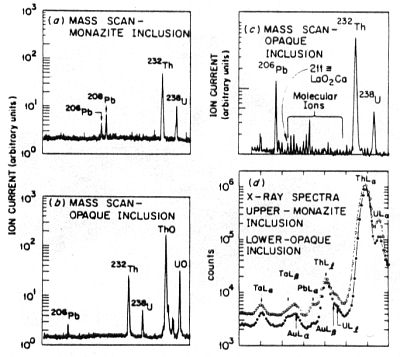|
Earth Science Associates |
|||||||||
|
||||||||||
|
Creation's Tiny Mystery |
||||||||||
|
|
< Prev T of C ... 12 13 14 15 Epi. Cat. App. Ref. Cred. Next > Radioactive Halos and the Question of Invariant Decay RatesA most important question pertaining to the evolution/creation issue is whether radioactive decay rates have remained invariant during the course of earth history. If they have, geochronologists are justified in interpreting various parent/daughter isotope ratios found in undisturbed rocks in terms of elapsed time. If on the other hand there have been periods in earth history where the decay rate was higher (i.e., during a singularity), then in general the isotope ratios in rocks would not reflect elapsed time except in the specific case where secondary rocks or substances containing only the parent radio-nuclide formed at the end of the most recent singularity. The practical significance of this last statement will be evident in the discussion of the secondary, U halos found in coalified wood specimens from the Colorado Plateau. Even though most of Joly's (4) measurements of U and Th halos showed their radii were about the sizes expected from the alpha decay energies of the U and Th decay chains, nevertheless he claimed there were slight discrepancies which raised questions about whether the radioactive decay rate had been constant over geological time. His result was not confirmed however by later halo radii measurements (5-10), which agreed to within experimental error with the theoretical sizes. To eliminate any uncertainty about this correspondence I irradiated specimens of various minerals with He ion beams of varying energies to produce different size coloration bands whose widths corresponded to the various alpha energies of the U decay chain. The results of these experiments, presented in Table 1, show there is excellent agreement between the U and Th halo radii and equivalent He ion produced penetration depths (2). The basis for thinking that standard size U and Th halos imply an invariant decay rate throughout geological time proceeds from the quantum mechanical treatment of alpha decay, which in general shows that the probability for alpha decay for a given nuclide is dependent on the energy with which the alpha particle is emitted from the nucleus. The argument is that if the decay rate had varied in the past, then the U and Th halo rings would be of different size now because the energies of the alpha particles would have been different during the period of change. This argument assumes that a change in the decay rate must necessarily be explainable by quantum mechanics, which is of course an integral part of the uniformitarian framework. Thus, the usual proof of decay rate invariance based on standard size U and Th halos is nothing more than a circular argument which assumes the general uniformitarian principle is correct. In fact, the failure of the uniformitarian principle to explain the evidence for creation presented herein invalidates the basis for the above proof. [p. 273] Polonium, Dwarf, and Giant Halos in MineralsOf the three types of unusual halos that appear distinct from those formed by U and/or Th alpha decay, only the Po halos, Fig.1 (b-d, n-r, r'), can presently be identified with known alpha radioactivity (1-3,11-13). Po halos occupy a special niche in my creation model, and these halos will be discussed in more detail subsequently. Several lines of evidence which indicate the enigmatic dwarf halos (see Fig. 2) were produced by some presently unidentified radioactivity have been summarized (1,12,14,15). The rapid etch from HF and the K/Ca inversion are strongly characteristic of highly radiation-damaged regions. The characteristics of the giant halos found in a certain Madagascan mica have also been summarized (1,14,16), and while no definitive evidence as yet exists for a radioactive origin, some halos with opaque inclusions in this same mica exhibit isotopic anomalies which raise questions about the uniformity of U and Th alpha decay. For example, the mass scans and x-ray fluorescence analyses shown in Fig. 3 clearly indicate that, whereas both the monazite and opaque inclusions exhibit 206Pb and 207Pb from U decay, the opaque inclusions exhibit a marked deficiency of 208Pb from 232Th decay (14).
Doc.: T of C ... #13 #14 #15 #16 #17 #18 #19 #20 #21 ... < Prev T of C ... 12 13 14 15 Epi. Cat. App. Ref. Cred. Next > |
|
|||||||
|
|
||||||||||
|
||||||||||
|
Earth Science Associates
|
||||||||||



